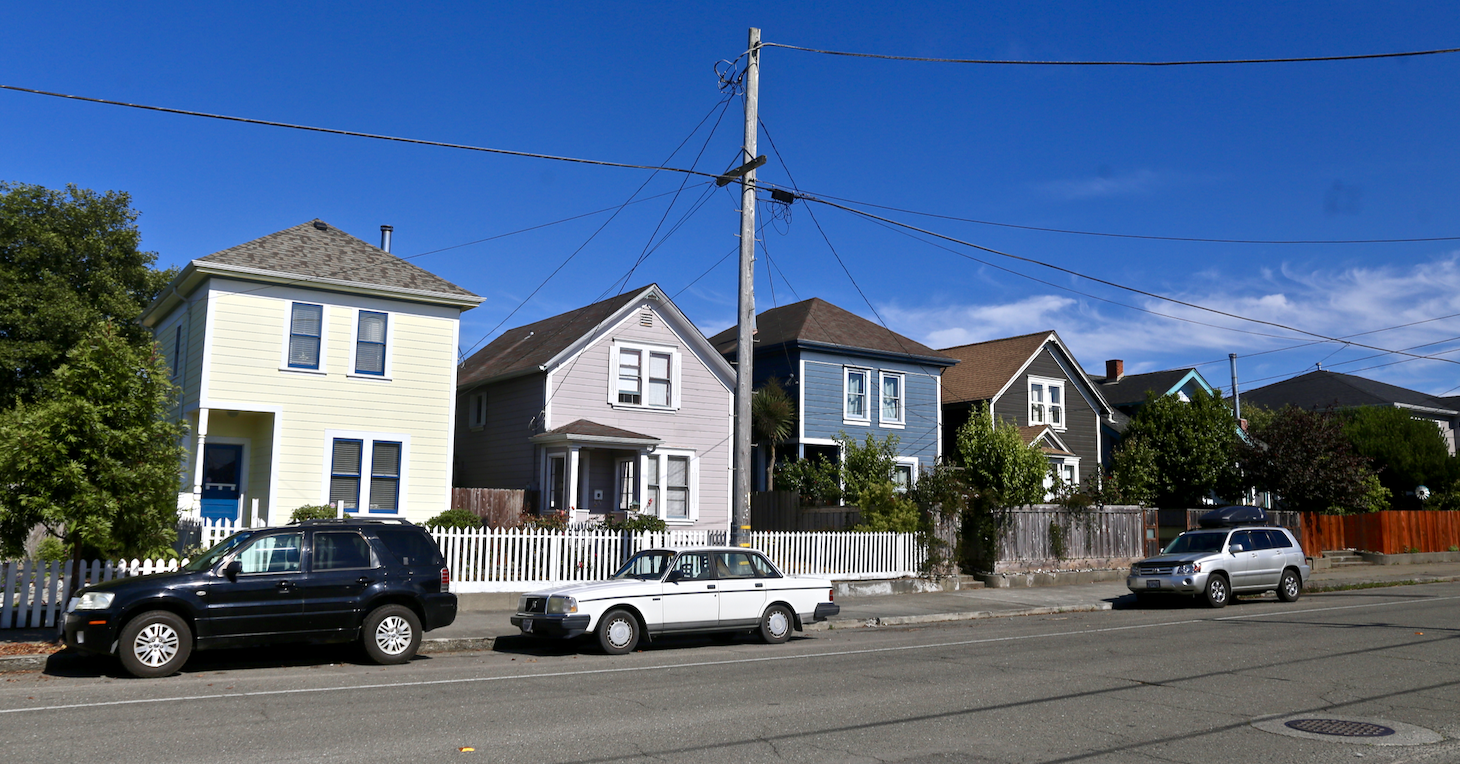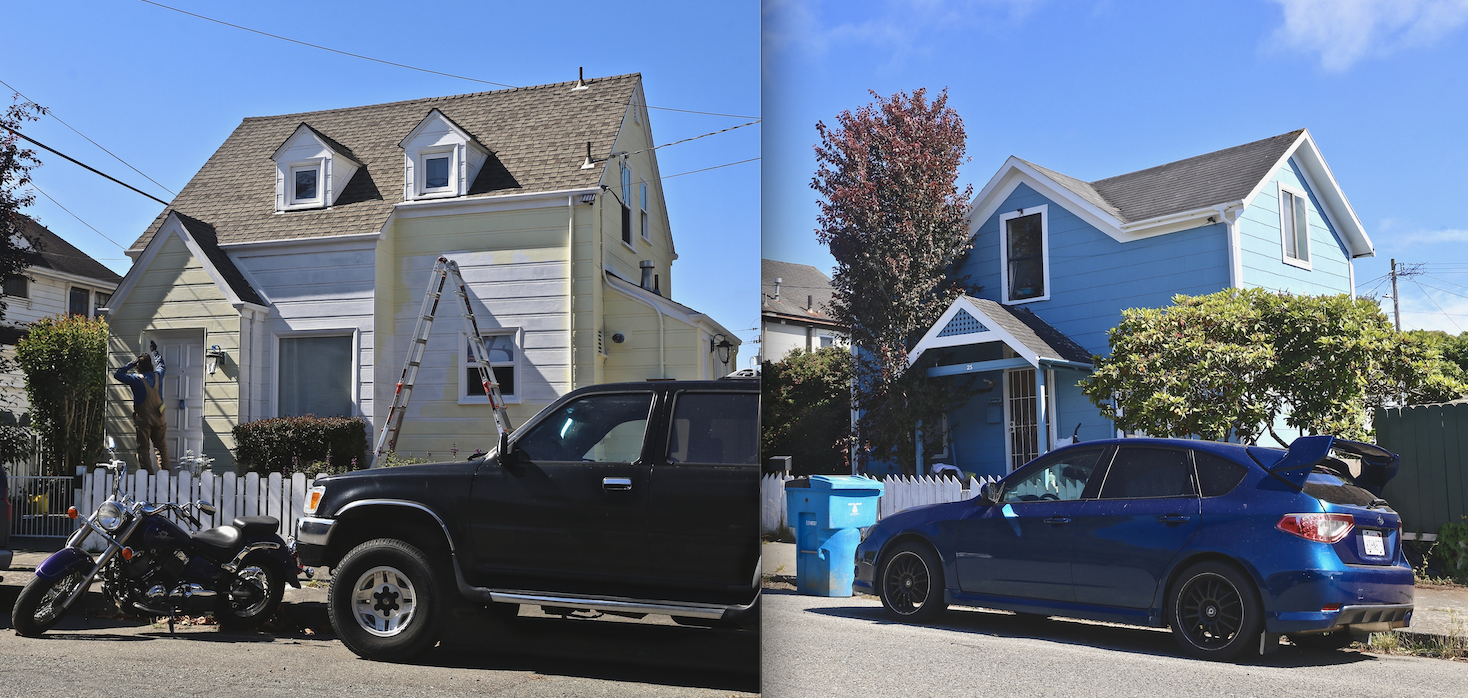
Aren’t these houses in Eureka adorable? Well, they’re on relatively small lots, too! | Photos: Andrew Goff
Welcome to the inaugural episode of “Land Use and You,” a new series that explores the latest in cutting edge and good old-fashioned land use policy. Ever wondered why housing costs are so damn high in Humboldt? Concerned that hordes of wildfire refugees and remote workers are coming to destroy our North Coast paradise simply by their very presence? Does your eyeball twitch every time someone says “HSU” and “polytechnic” in the same sentence? Are you mad as hell and just can’t take it (1) anymore?
Alright, champ, let’s walk it back a bit. Anger alone isn’t going to resolve Humboldt’s housing crisis (2). Nope, solving the problem is going to require a concerted effort by the people, their representatives in local government and our local builders. There are many things that need to go right — some big and some small. Let’s start with something small.
Small Lot Subdivisions. A small lot subdivision is exactly what you think it is. It’s a subdivision where instead of the lots being 5,000-8,000 square feet, they are only about 2,000-3,000 square feet. Other than that, they function pretty much exactly like a conventional subdivision. The subdivision occurs, the lot is created, someone builds a house, a person buys the house and moves in, and just like that — another happy homeowner.
Here are some additional details to round out your understanding:
Availability. Small lot subdivisions are currently only available in Eureka, but Arcata and the County are looking into allowing them. Oddly enough, SB 9 (Atkins) is currently being considered by the legislature and would allow lot splits to create lots as small as 1,200 square feet.

Like this! Graphic from Eureka’s zoning code.
Subdivision vs Lot Split. The technical term used by planning departments is “subdivision” regardless of whether you are creating one new lot or one hundred. It’s okay to use the term “lot-split” if you feel more comfortable, but it will still technically be a subdivision.
Access. Access is typically provided via street frontage. If street frontage isn’t available to serve the new lot(s), you will need to use the alley, a recorded access easement, or (in extreme cases) create a flag lot. Flag lots waste space and you should only pursue that option if the planning department insists.
House Size. The size of the house that you are able to build is directly related to the size of the lot. This is regulated by something called Floor Area Ratio (FAR). To determine how big of a house you can build, you multiply the lot size by the FAR. A common FAR in low density residential zones is 0.6. On a conventional 5,000 s.f. lot, this would allow a 3,000 s.f. house. On a 2,000 s.f. lot, this would allow a 1,200 s.f. house. Small lot subdivisions create houses that are “big enough”, not “big”.
Building Setbacks. To accommodate the smaller lot sizes the building setbacks have to be reduced as well. Building setbacks of around 5-10’ are typical — anything in excess of that makes it very hard to fit a home onto the site. For comparison, a typical 5,000 square foot lot will often require front and rear setbacks of around 20’. In some cases (e.g. Eureka) you’ll be able to build right up against a side property line to create a townhouse or rowhouse style development.
Affordability. When it comes to market-rate housing, newly constructed housing is always more expensive than older housing — the same way that new cars are always more expensive than used cars. However, given that the houses built on small lots tend to be small, they tend to cost less.
Financing. Small lots often result in small single-family homes. As such, they are bought, sold and financed just like any other single-family home. Your trusty local real estate agent and mortgage banker should be more than up to the task.

History in Humboldt. Small lots have been in Humboldt for over 100 years. Prior to the minimum lot standards being imposed in the 1950’s, lots could be as small as you damned-well-please. At 12th & J Streets, there is a row of adorable houses built on 25’ wide lots (you may remember them from the picture at the top of this post). There are some great examples in Eureka at West Washington & California Streets (like the one in the image above on the right). Though perhaps cutest of all would be 823 13th Street (above, left) — all on a 1,800 square foot lot!
Small Lot Subdivisions vs ADUs. The new homes that are built on small lots tend to seem a lot like ADUs, but there are important distinctions: ADUs are built on the same lot as the main house and cannot be sold separately. As such, ADUs create rental housing whereas small lot subdivisions create new (small) home ownership opportunities. ADUs offer some additional perks due to State law: impact fees can’t be charged, off-street parking is rarely required, utilities can be shared with the main house, etc. However, adding an ADU to an existing single family home will likely not be as profitable as constructing a new (small) single family home on its own lot and selling it to a eager new homebuyer.
Seniors. Small lot subdivisions are great for seniors that are looking to downsize or age-in-place. If their current house has a backyard large enough, they might be able to subdivide and build a new, smaller house right out back. Done smartly, grandma might be able to continue to tend her prized rhodies from the comfort of her new aging-in-place compatible small home.
Well, there you have it, the key takeaways of small lot subdivisions. Ask for them by name.
If for some reason your town doesn’t allow small lot subdivisions, be advised that amending the zoning code to allow them need only take a few months. Call your representative and explain why you think small lot subdivisions should be allowed in your town.
FOOTNOTES:
1. “It,” here, is defined as “the thing that government allowed to happen or didn’t allow to happen.” (Back.)
2. If you felt triggered by the term “housing crisis” because you are of the view that there is no housing crisis in Humboldt — please don’t be concerned. This topic will be addressed in a future episode. In the meantime, please practice empathy for those struggling to find safe, decent and affordable housing in Humboldt County. (Back.)
###
Brian Heaton is a local pro-housing advocate with a professional background in city planning. Views expressed are his own and do not represent those of any government.
CLICK TO MANAGE